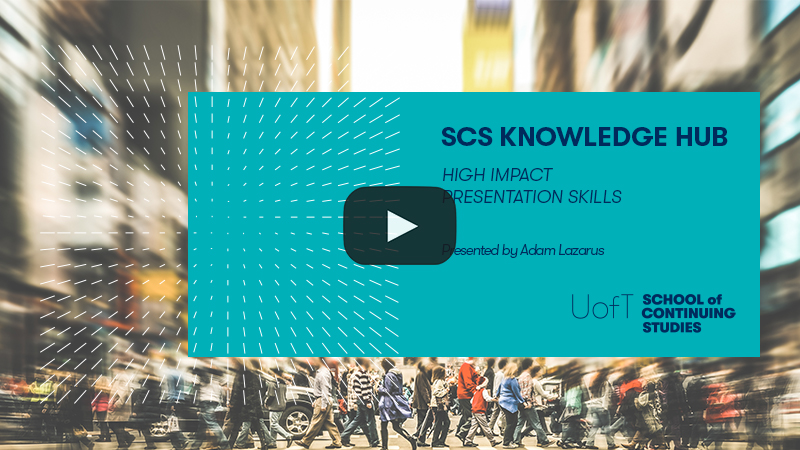
“You need to enjoy doing what you’re doing, and if you don’t, it reads. Something in you needs to stand behind what you say or the audience will turn off.” - Adam Lazarus, public speaking expert
The latest free Knowledge Hub webinar featured public speaking expert and SCS instructor Adam Lazarus, who shared valuable insight into how anyone can begin to improve their presentation and communication skills.
Lazarus kicked off the webinar by asking participants to picture someone who they think of as an excellent communicator and then share or make a note for themselves about what makes that person great at communication.
“It’s very important to articulate for yourself what you think is great so that you have a measure for yourself of what you want to emulate,” he explained.
“I’m going to take a guess and say somebody picked Obama. And I’m going to also say, I’m sorry, you cannot be the next Obama. You can only be the next you. I’m not interested in who you choose, but why you choose who you choose. So you can take those qualities and figure out how you present them.”
Lazarus then asked participants what stands in the way of excellent communication and questioned how many people feel nervous speaking publicly, whether in one-on-one interviews or speaking in front of a boardroom full of people.
“It’s considered the number one fear amongst human beings, even above death, according to The Book of Lists,” he said.
“Now I hope it’s not your case that you feel like you’d rather be dead than communicating,” he added. “And I don’t say that to diminish the experience of feeling really bad and uncomfortable, anxious, sweaty and tired – all the things that happen…but the good news is that public speaking and communication is a skill that can be learned.”
Lazarus went on to share his approach to effective public speaking and communications, which includes, five main aspects:
- Pleasure: “You need to enjoy doing what you’re doing, and if you don’t it reads. Something in you needs to stand behind what you say or the audience will turn off,” Lazarus explains. “Often what happens because we’re nervous, is we diminish our own enthusiasm towards what we say. We can’t begin there.”
- Complicité (or connection): Lazarus says that despite advice some people may have received to look above the audience instead of directly at them to alleviate nerves, it’s actually important to do the opposite. “We need to look at the audience and read what’s happening back.” When you’re paying attention to your audience and their feedback, you can adjust to keep them engaged.
- Authenticity: You are who you are and you cannot be anyone but who you are. You are dynamic in front of somebody in your life, whether it’s your partner, your dog, or your friends, where you light up and sound like you care. And what we want to do is pull that person up in front of the room, appropriately.”
- Mistakes or failure. “I promise you, you are going to make mistakes,” Lazarus said. But he explains the important thing is not to get hung up on mistakes or convince yourself the audience has been greatly upset by a fumble you might make during a presentation.
- "Today I was good, tomorrow I hope to go on. Today I was bad, tomorrow I hope to go on.” Inspired by a saying from a teacher Lazarus studied under, the quote refers to the idea of communication improvement being a lifelong process. Lazarus says we don’t need to limit working on these skills to when we have a formal presentation or communication to prepare. We can take everyday communication as an opportunity to practice and improve our skills. He says: “We’re always working at communicating, getting our message across, being impactful, and dynamic.”
See the full webinar recording, including a follow-up question and answer session, below.
Visit our Workplace Communications page for more information about our courses related to communications and presentations.














